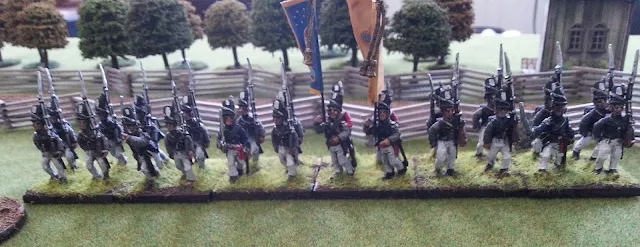My 1st Brigade consist of the wonderful figures from Knuckleduster miniatures. Parading are the 9th, 11th, 22nd and 25th U.S. regiments. Additional firepower is provided by Captain Nathan Towson's artillery company. Leading the brigade is Scott himself. This portrait figures is based on the painting "Those are Regulars" by
Charles McBarron. It certainly captures the spirit of the man. Each regiment is made up of 24 figures which gives a very nice table top appearance. Regimental flags are from Flags of War.
General Winfield Scott's 1st Brigade of General Brown's army in 1814 is the stuff of legend. Evan today, regiments in the United States army trace their lineage to these regiment and soldiers know the motto "Those are Regulars, By God" earned at the battle of Chippewa.
At Buffalo in April 1814, Scott had established a camp of instruction and instituted a major training programme while they waited for Brown and the start of the campaign season. The army of six regular U.S. regiments were all veterans of the previous campaigns. Here Scott drilled his troops for seven to ten hours every day. This ranged from platoon to company to battalion dril and special field days for brigade drill. He standardized the small arms drill using the 1791 Manual of the French Revolutionary Army. Scott purged his regiments of any remaining inefficient officers who had gained their appointments through political influence rather than experience or merit. He insisted on proper camp discipline including sanitary arrangements. This reduced dysentery and other enteric diseases which had been heavy in previous campaigns.
Scott had been unable to obtain enough regulation blue uniforms for his men. Although correct uniforms had been manufactured they had been sent to Plattsburgh and Sackets Harbor. Once the error was discover over 2,000 new uniforms were made up and despatched to Buffalo for Scott's regiments. Because there was insufficient blue cloth, short jackets or roundabouts of grey cloth were sent
instead. This was a slight as gray were traditional associated with militia units. When Scott received the grey roundabouts, he gathered up the blue coats from his brigade and gave them to the 21st US Infantry (one of the units in the Brigade of Brigadier General Eleazer Wheelock Ripley), because "the black coatees of the 21st are a disgrace to the uniform and soldier of the army of the United States." Officers of his brigade, who purchased their own uniforms wore the standard blue uniform. Now uniformly equipped his brigade would step into legeand attitred in their gray jackets. They were to be a match for the British regulars across the Niagara river.






















